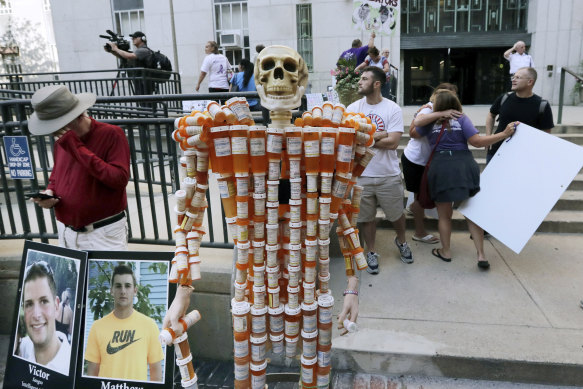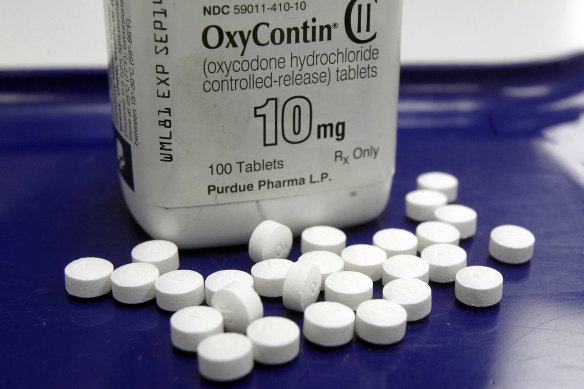Opioids or an open mind? The science of treating pain is changing fast

Examine, a free weekly newsletter covering science with a sceptical, evidence-based eye, is sent every Tuesday. You’re reading an excerpt – sign up to get the whole newsletter in your inbox.
“I got my life back now,” Johnny Sullivan says into the camera, as a banjo tinkles behind. “Now I can enjoy every day.”
Across the bottom of the screen runs a caption: OxyContin, 70mg/day.
A skeleton made of pill bottles stands with protesters in August 2019 outside a court in Boston where a judge was hearing arguments against opioid maker Purdue Pharma.Credit: AP
The year is 1998. Sullivan is Purdue Pharma’s poster boy for what is fast-becoming the default treatment for strong pain: opioids.
In a decade, Sullivan will be dead. He went from success story to opioid addict. He fell asleep at the wheel and flipped his truck, the Milwaukee Journal Sentinel reported. Sullivan’s story was on my mind as I wandered the booths at the Australian Pain Society’s annual scientific meeting in Canberra last week.
Because, more than 20 years after Sullivan filmed that advert, the wheel of pain is turning. Most of the opioid exhibitors that once dominated pain conferences were gone, replaced by sessions on social interventions, teaching children about pain, sleep and pain, even one dealing with fear.
“And that’s because the evidence has changed,” says Dr Joshua Pate, a member of the society’s scientific program committee. “It’s in favour of active, supported self-management. There is still a role for opioids in some conditions. But the role of them is different, and smaller.”
Pain conferences used to be full of opioid-funded razzle-dazzle. The companies would install booths three storeys high and hand out goodie bags with the aim of capturing the attention of any doctor who might wander by.
The meeting I attended was much smaller. I didn’t get a single goodie bag. The Pain Society’s president, Joyce McSwan, confirmed there had been a “shift to have a more balanced approach in the exhibition hall”.
But while the science is shifting, it seems that pain patients have not been brought along for the ride.
“The whole community understands taking a painkiller. Do they understand physical movement, psychological training? The community does not necessarily know yet those things are possible,” says Giulia Jones, CEO of consumer advocacy body Painaustralia, which has received funding from opioid manufacturers.
The evidence has changed
The modern opioid boom was fuelled by a huge marketing campaign driving two key messages: opioids provide strong pain relief and are safe.
It was clear in 1999, a year after Sullivan filmed his advert and as overdose deaths started to tick up, that they came with significant risks.
“I got my life back now,” Johnny Sullivan said into the camera, as a banjo tinkled behind. “Now I can enjoy every day.”Credit: AP
But there’s been a second, more subtle shift: scientists no longer think of them as particularly effective painkillers for every condition.
In 2018, JAMA (The Journal of the American Medical Association) published a meta-analysis of 96 randomised controlled trials of opioids for chronic pain. They beat a placebo – but only just, decreasing pain intensity by about one out of 10. And, of course, using them comes with a grab bag of risks.
“Twenty years ago we were red-hot on opioids as a strong pain relieving medicine,” says Professor Christine Lin, who studies opioids at the University of Sydney. “But reviews of studies have consistently shown a very small treatment benefit at the short term.”
That’s a hard sell for patients, who were given opioids by their doctors and then stripped of them – and often given few alternatives or support.
“People feel victimised,” says Painaustralia’s Jones. “There’s a lot to do to treat people with chronic pain justly and compassionately.”
The modern science of pain
Historically, scientists believed there was a tight link between tissue damage and pain. If you had pain but no damage, you must be making it up.
This has proven to be wrong. Pain is subjective – it’s a feeling, generated by your brain – and so circumstances really matter.
Says Pate: “Pain is really complex. We’re not saying the biological doesn’t matter – it’s just there are so many factors that contribute to every pain experience. And many of these are social or psychological.”
Depression and anxiety are among the strongest predictors of chronic pain. People who have an optimistic bias seem to feel less pain. Cancer patients with supportive partners feel less pain. The more worried a parent is about pain, the more likely a child is to be in pain two weeks after their operation.
Given all that, you can see why biological approaches such as opioids have their limits. Modern chronic pain treatments often centre around cognitive behavioural therapy, pain education and exercise-based rehab.
Each treatment produces effects, but they are small. Now scientists are starting to combine these treatments in novel ways – and producing much larger effects.
“For me,” says Pate, “the optimistic way of looking at it is there are now so many more targets for potential treatments.”
Disclaimer: Conference organisers provided flights and accommodation to the journalist, who was a speaker at the conference.
Enjoyed this article? The Examine newsletter explains and analyses science with a rigorous focus on the evidence. Sign up to get it each week.
Most Viewed in National
From our partners
Source: Read Full Article

